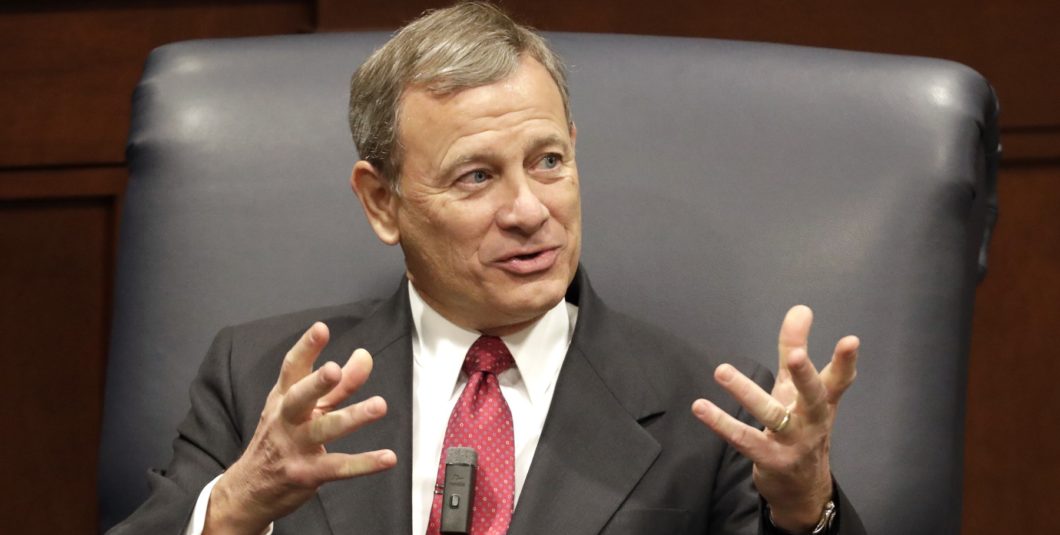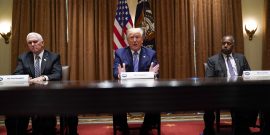A legal world that promoted originalism would generate greater stability.
What Does the Chief Justice Maximize?
John Roberts has been in the news quite a bit lately for his decisive votes at the Supreme Court, with conservatives and formalists, including me, criticizing much of his performance. But given his position as both chief justice and the swing voter on the Court, his behavior is not likely to change. Chief justices have historically pursued different interests than associate justices because they identify less with any particular jurisprudence and more with the Court as an institution. Roberts also commands a better position to press for his institutional interests than most of his predecessors because he sits in the middle of the Court ideologically as well as physically and thus can often control the content and even the pace of its decisions.
The Institutional Interests of the Chief Justice
Chief Justices identify Supreme Court eras. We speak of the Marshall Court, the Warren Court, and now the Roberts Court. As a result, a chief justice’s personal jurisprudence will not define his legacy nearly as much as that of an associate justice like Joseph Story or Antonin Scalia. He will be remembered instead by the Court over which he presides and its place in Supreme Court history. The chief justice also has important ceremonial duties, such as the administration of the oath at inaugurations and the supervision of the entire federal judiciary, that contribute to his self-image as a statesman rather than a mere legal oracle.
These institutional interests naturally move a chief to weigh the effect of the Court’s decisions on public opinion. That concern in turn inclines him to distribute victories among the partisan factions of the nation more than other justices would like, so as to maintain the diffuse popular support for the Court. It also makes him think of the long-term effect of jurisprudential decisions on the Court’s standing. As a result, a chief justice is likely to be more Machiavellian than other justices, focused on a longer time horizon and less wedded to his preferred outcome in an individual case. When he has a position, either ideological or jurisprudential, to impress into law, he is more likely to try to search for the time and case in which it is most politically palatable to do so.
We can see this kind of institutionalist, long-game approach in almost all the chief justices who are well remembered. Chief Justice John Marshall, still regarded as the greatest of all, was quite Machiavellian in his most famous and consequential decision, Marbury v. Madison. The result in the case was to dismiss the lawsuit against Thomas Jefferson’s administration and thus give his distant cousin and political opponent a formal victory in the public mind. But, of course, Marbury also established the principle of judicial review, not only sound as a matter of law but also very congenial for the Federalist Party of which Marshall was a member, as it allowed oversight of the increasingly Democratic-Republican popular branches. The price of the opinion, however, was a substantial departure from sound legal reasoning in other respects. Marshall opined on the merits of the case despite concluding that he had no jurisdiction to consider it, and he interpreted a statute in an implausible way to conclude that it was unconstitutional and thus allow him to establish the principle of judicial review.
In the New Deal, Chief Justice Charles Everett Hughes was a Republican chief justice who faced threats of court packing by an overwhelmingly Democratic Congress. In NLRB v. Jones & Laughlin, he reacted by leading the retreat from the Court’s jurisprudence policing Congress’s authority under the Commerce Clause, permitting Congress much more substantial authority to regulate the economy. He effectively overruled Carter v. Carter Coal, a case that had stymied the New Deal, even though he concurred in some portion of that decision a few years earlier.
Roberts often opts to write separate opinions when he is the deciding vote, depriving the Court of any majority opinion that will constrain him in the future.
More recently, William Rehnquist, for whom John Roberts clerked, demonstrated that where you stand on the Court may depend on where you sit. As an associate justice, Rehnquist was dubbed the lone ranger for solo dissents that used a pen as a stiletto to eviscerate the majority. As chief justice, however, he dissented less, moved toward the center of the Court, and was far less rhetorically powerful. For instance, Rehnquist had been the most vociferous critic of the so-called Miranda rule as an associate justice. But as chief, he wrote the opinion in Dickerson v. United States, entrenching it as a matter of stare decisis. It was just too damaging to the Court’s institutional position to junk its one rule of law that everyone knew from television shows.
A recent biography showed that John Roberts was so conscious of his position as chief that he changed the tradition of all justices being named sequentially: While chief justices had previously been included in the total number of justices, Roberts separated them. For instance, Roberts welcomed Elena Kagan as the 100th associate justice, not the 112th justice.
His performance this term has been completely in keeping with that distinctive self-consciousness and concern with protecting an institution that he no doubt sees under threat. Court packing again poses a substantial threat. Several Democratic candidates for president called for it, and Democratic senators have threatened to eliminate the filibuster, so it might be achieved.
No chief justice wants to be remembered as the one who presided over court packing. Thus, it is not surprising that in high-profile issues Roberts moved decisively left, particularly in cases that concerned DACA and abortion rights. Dreamers and the right to abortion command majorities in the country and overwhelming majorities among Democrats who will decide whether court packing moves forward in a unified Democratic government.
On the other hand, Roberts wrote two opinions delivering long-sought victories to conservatives in Seila v. CFPB, where he broadened the President’s power to fire the heads of administrative agencies and in Espinoza v. Montana Department of Revenue where he held that religious schools could not be prohibited from participating in programs in which a state contributed to private school funding. No one outside the beltway cares much about the removal power of the President, and the exclusion of religious schools is unpopular among the public, though not among academics of course.
Even in the DACA and abortion cases, Roberts may have been creating a foundation for conservative victories at a more propitious time. The DACA case strengthened the requirements for agency explanations of its decisions, which may be used to constrain the administrative state. His decisive opinion for himself alone in the abortion case subtly cut back on the balancing test that would likely invalidate more restrictions on abortions. John Roberts was a history major at Harvard and his model is John Marshall. He wants to leave the Court as strong as he found it, even if that means bobbing and weaving to achieve his jurisprudential and ideological goals.
The Chief as Swing Vote
Chief justices have more power than other justices because they have the right to assign the opinion when they are in the majority, choosing the justice who is most likely to write an opinion that meshes with their interests. But Roberts has greater power than most of his predecessors because he is ideologically in the middle of the Court. His vote is very often decisive. As a result, he can often dictate the result in politically charged cases that come out 5-4. Even better, from his perspective, he can write separately, depriving the Court of any majority opinion that will constrain him in the future. That maneuver leaves him freer to control the results in the next case in the area. Because he will enjoy this power for some time, his time horizon is even longer than most chiefs.
Even beyond deciding cases, Roberts’ median position allows him to influence when a case will be heard. While it takes the votes of only four justices to hear a case, justices may be reluctant to do so unless they know where Roberts is going to come down. His power explains why the Court declined the opportunity to hear any Second Amendment cases next term, although all the conservative justices other than Roberts are on record expressing concern about the grudging manner in which many lower courts have treated Second Amendment rights. Roberts, however, probably views expanding Second Amendment doctrine as too controversial at this time, even if he agrees with the conservatives on the merits.
Because of his position as the median justice, Roberts is the most powerful chief justice for at least the last 150 years. We can expect him to wield this power in the future as he has this year—deliberately and craftily—to insulate the Court from backlash while incrementally pursuing many conservative goals.



